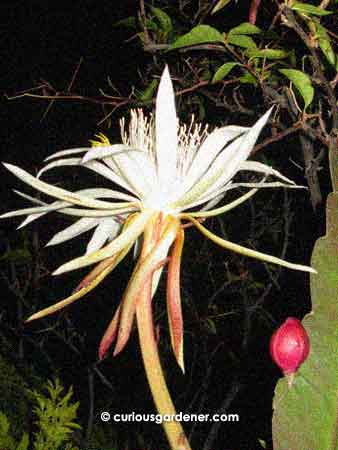
A Keng Hwa flower blooming along the same leaf that had a fruit growing on it. The fruit forms at the base of the flower stalk. Sometimes the entire flower drops off after blooming, but on rare occasions - I assume when pollination takes place - part of the stalk remains after the flower drops, and it develops into one of the cute fruits.
We’ve been keeping a little secret over the last few months. In April, I mentioned that our Keng Hwa plant had produced those Dragonfruit-like little fruits as it sporadically does. This time, though, we kept a closer eye on them as they grew – “grow” being a relative term, as the fruit grew to the “great” ol’ size of 2cm long…
We’ve since observed that the fruit forms at the base of the flower stalk. Assuming that pollination of the flower is the issue here, when that takes place, the flower lingers on the plant for a few days instead of falling off the day after the flower blooms at night. The lingering flower will eventually drop off, but the base of it, comprising up to 2cm of the stem, will remain attached to the leaf.
From a pale green, the fruit lightens to pale yellow, then eventually turns bright pink.
It took about 2 months for the first fruit to ripen, then start dying on the plant. Finally, it fell off, and Curious Mama pounced on it. The drying skin was now stretched over something hard within. Since we’re believers in letting nature take its course, we put the drying fruit to rest with another potted plant, and within a few days, saw that the skin had rotted away to reveal…

This ugly mass you see is the dried Keng Hwa pod that we opened carefully once we saw the almost translucent green stems peeking through the decaying pod walls. The black seeds were about 4mm long and quite smooth to the touch.
…little black seeds that had already sprouted within the dying pod! We were so excited, and yet apprehensive, because we had no experience with the oxypetalum plant at seed stage. Unfortunately, with the hot weather we had back in August, the little seedlings died out.
The good thing was, there was a second fruit on the plant. When it matured, I watched it like a hawk until it dried and fell off during a rain storm. There were a few little seedlings showing again, and I left them in the pod because they didn’t detach easily, and I didn’t want to kill any by forcing them from their version of a warm, cosy womb, or risk breaking their tap roots. Finally, though, I managed to extract two seedlings and planted them in little pots of Tref. They sat there with their long, fat seed leaves showing for several weeks and not doing any apparent growth. We got worried as there were no other seedlings, and the adult plants weren’t showing signs of fruiting again yet.
It took about 6 weeks for the first true leaf to finally emerge. It was a miniature of the adult leaf, but shiny and a vibrant, bright green. What caught our attention as it grew bigger was that it seemed to have little cactus-like needles showing at each lobe(?). That was interesting because our adult plants don’t have these little spikes. They’re very fine, though, and not dangerous at all.

This is the first Keng Hwa plant we've ever grown from seed. After the first main leaf grew long enough to flop downwards, little side leaves began to grow near the base of the leaf. When they first emerge, the leaves look like a little green hand raised in the air!
The leaf of the first plant has kept growing and is about 12 cm long now. It still looks young, healthy and succulent, and has thrilled us by starting to branch out.
Yes, our plants constantly provide us with lots of entertainment… ![]()
Right now, these cute little Keng Hwa leaves are growing out from some of the lower lobes. The main leaf is hanging down due to its size and weight, and the new leaves are perkily growing upwards and towards the light source. I’m sure they’ll eventually succumb to the floppy nature of the Keng Hwa’s leaves and will droop, too. We can’t wait to see what the plant will do next, but had to share the experience of going from plant to fruit to seed, back to plant. 8)

That’s cool.
Wonderful post. Thank you.